Want to learn how to use an SEO title tag generator in WordPress?
SEO titles are critical to capturing your target audience’s attention and enticing them to engage with your website. They also play a vital role in communicating the subject of your content to search engines.
In this blog post, we’ll show you how to use an SEO title tag generator in WordPress to boost your clickthrough rate (CTR) and win more traffic.
In This Article
- What Is an SEO Title Tag?
- Are Title Tags Good for SEO?
- How to Use an SEO Title Tag Generator in WordPress
- ChatGPT: The Technology Behind the AIOSEO Title Generator
- 6 Tips to Boost Your CTR With SEO Titles
- SEO Title Tag Generators: Your FAQs Answered
- Save Time & Grow Your Traffic With an SEO Title Generator
What Is an SEO Title Tag?
An SEO title tag is a piece of HTML code that represents the title of a page.
In your website’s HTML code, it looks like this:
<title>Your Page Title</title>For users, this information is displayed as a clickable link on the search engine results page (SERP).
Here is an example of the SEO title tag on the SERP when someone searches for “blog ideas.”
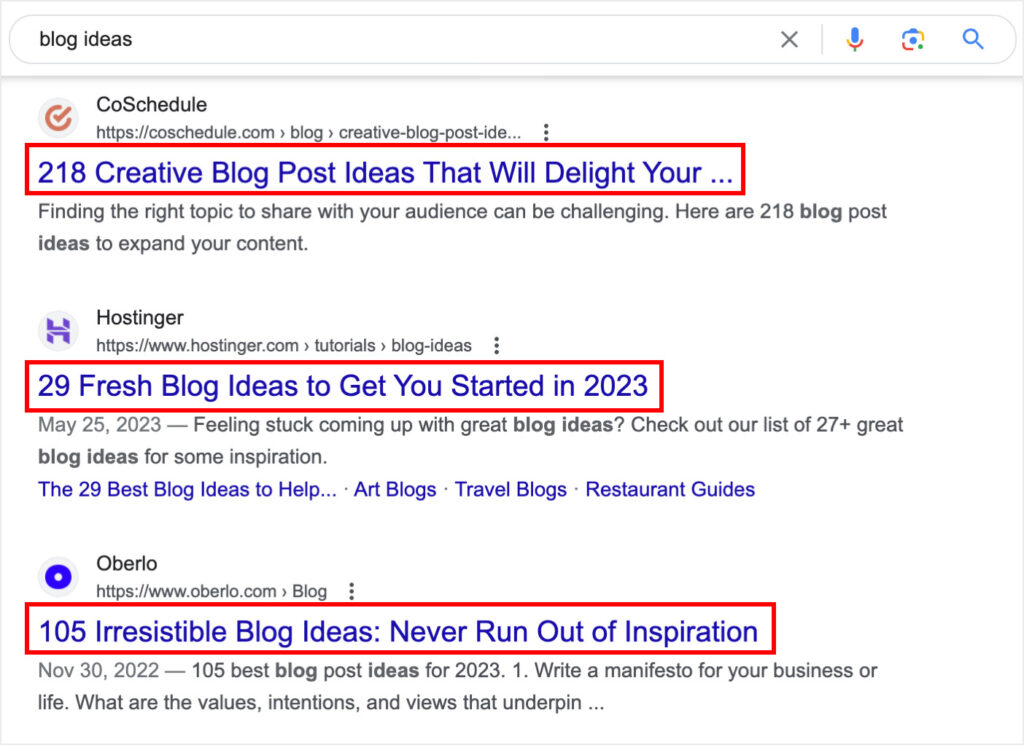
Note: SEO titles are also called meta titles. We will use both terms interchangeably in this blog post.
Simply put, SEO titles signal to users and search engines what your page is about.
Are Title Tags Good for SEO?
Yes. Title tags are a cornerstone of effective SEO.
Not only do they help search engines understand your page, but they also convey to users that you have the content they’re looking for.
Think of meta titles like first impressions. You have a unique, one-time opportunity to capture your audience’s interest and entice them to visit your website.
With each visit, you win a vote of confidence in the eyes of search engines. Over time, they’ll understand that you have what people want. This is an important component of Google E-E-A-T, which can indirectly but positively impact your site’s SEO.
Note: Google E-E-A-T stands for Experience, Expertise, Authoritativeness, and Trustworthiness.
How to Use an SEO Title Tag Generator in WordPress
Ready to use an SEO title tag generator in WordPress?
Let’s get started.
Note: The AI Title Generator is exclusive to AIOSEO paid plans. Click here to upgrade.
Step 1: Download and Install the All in One SEO (AIOSEO) Plugin
The first step to using an SEO title generator in WordPress is downloading the All in One SEO (AIOSEO) plugin.

AIOSEO is trusted by over 3 million savvy website owners, with thousands of 5-star reviews. It includes several SEO features and tools to grow your organic visibility while making it easier than ever to implement SEO best practices on your website.
One of the latest features is the revolutionary AI Title and Description Generator. This module saves you time from crafting countless meta titles and descriptions, all with just a click.
As for installation, you’ll be up and running in a short 10 minutes. The setup wizard walks you through each step of the process, so you can start optimizing from the get-go.
If you’d like a complete tutorial, visit our AIOSEO installation guide.
Step 2: Create an OpenAI Account
Before you can start generating titles, you’ll need to set up an OpenAI account. This account will allow us to create an API key, which we can use with the SEO title tag generator in WordPress.
To get started, create an OpenAI account.
Next, add your email address and click Continue.

You should then receive an email verification from OpenAI. Click the Verify email address button, which will automatically take you to the account creation page.
From here, you’ll enter your personal information and click Continue.
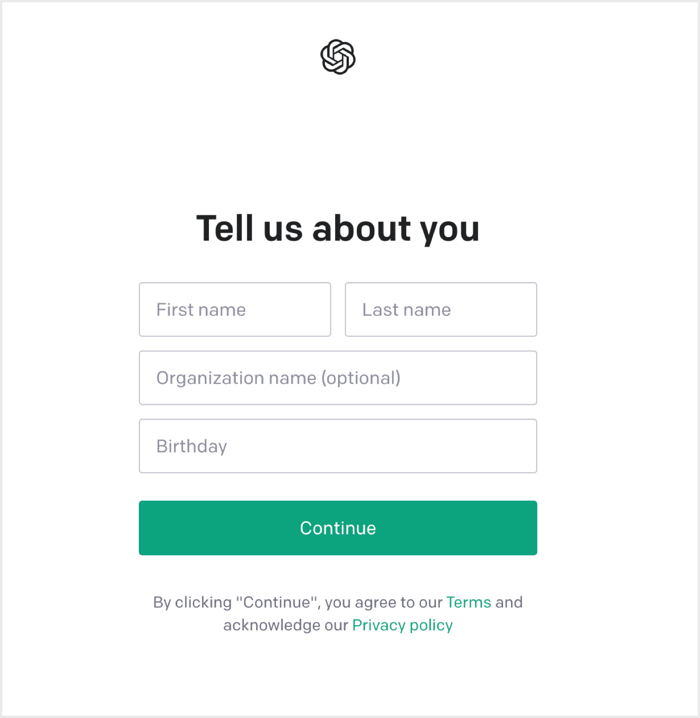
Once you complete the account creation process, we’ll need to locate the API key.
Click on your account to reveal a dropdown menu. Then, select View API Keys.
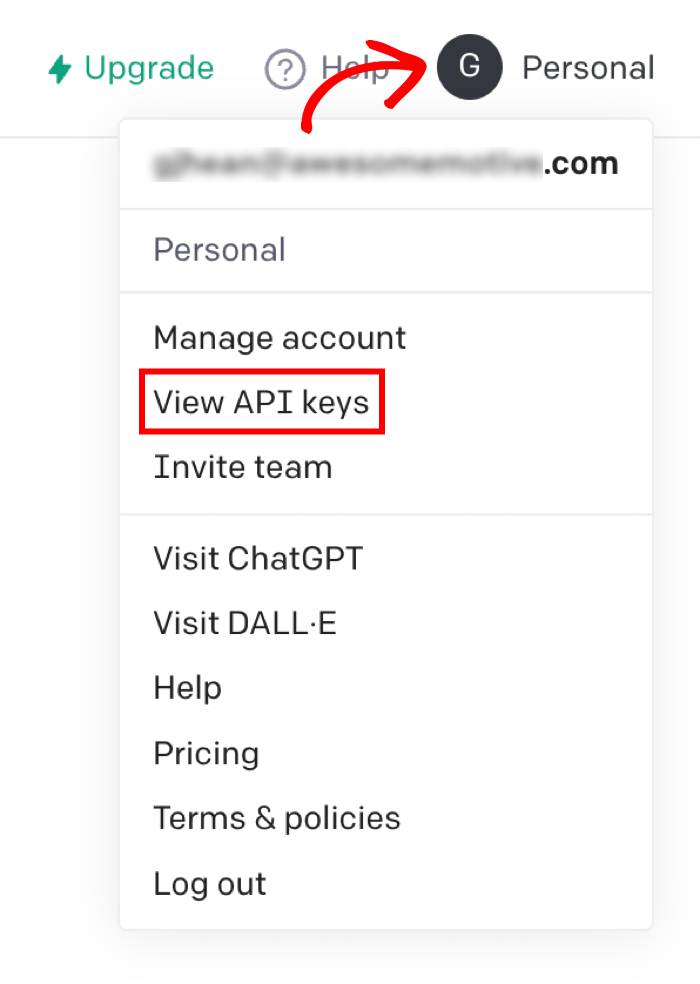
Next, you’ll want to Create a new secret key.
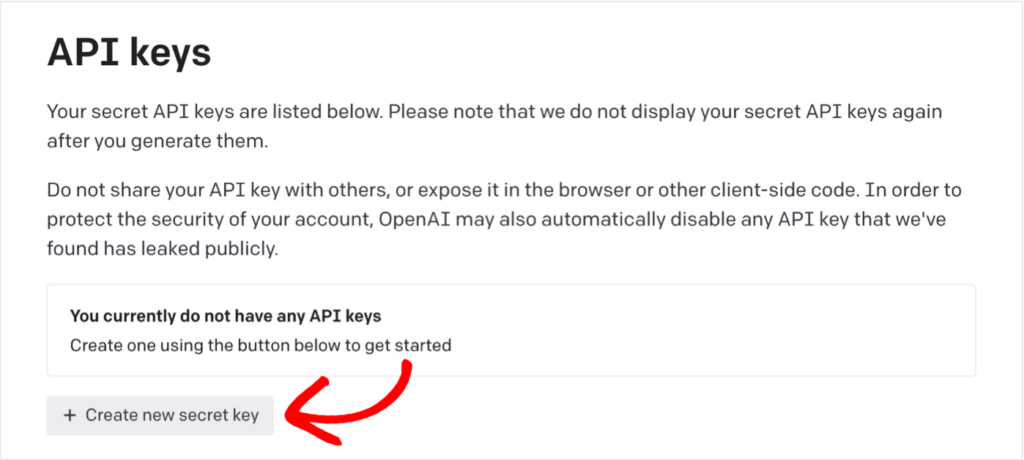
Then, name your secret key (it can be anything you want) and click Create secret key.
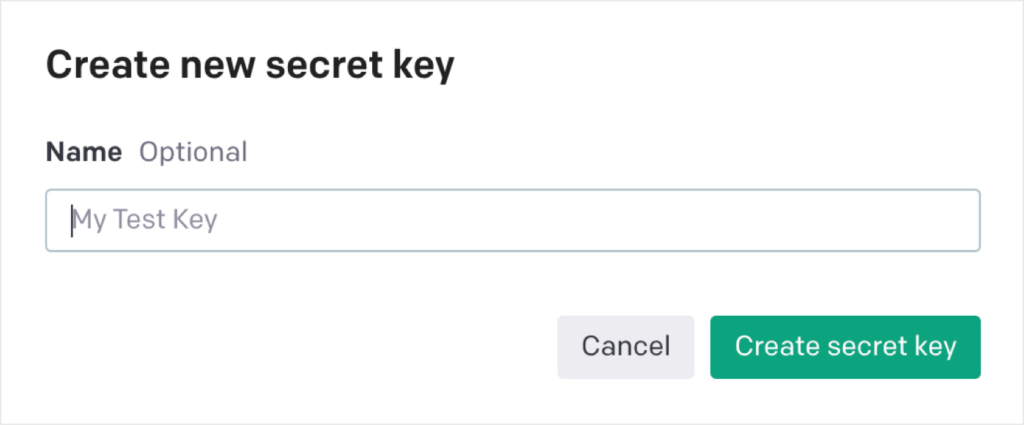
A popup will reveal your new secret key. Go ahead and click the green button to copy.
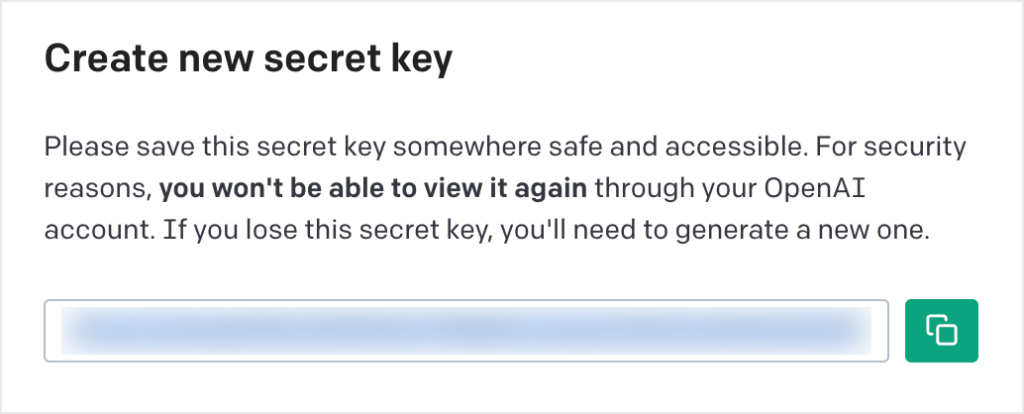
Step 3: Add Your OpenAI API Key to AIOSEO
Now, we’re going to jump into WordPress and add our newly acquired API key.
Once you’re in the editor of WordPress, open any existing post or page.
Then, scroll down until you see the Post Title of the AIOSEO meta box. Click the robot button on the right.

A window will pop up where you can paste your API key. After you have pasted it into the URL bar, click Connect.
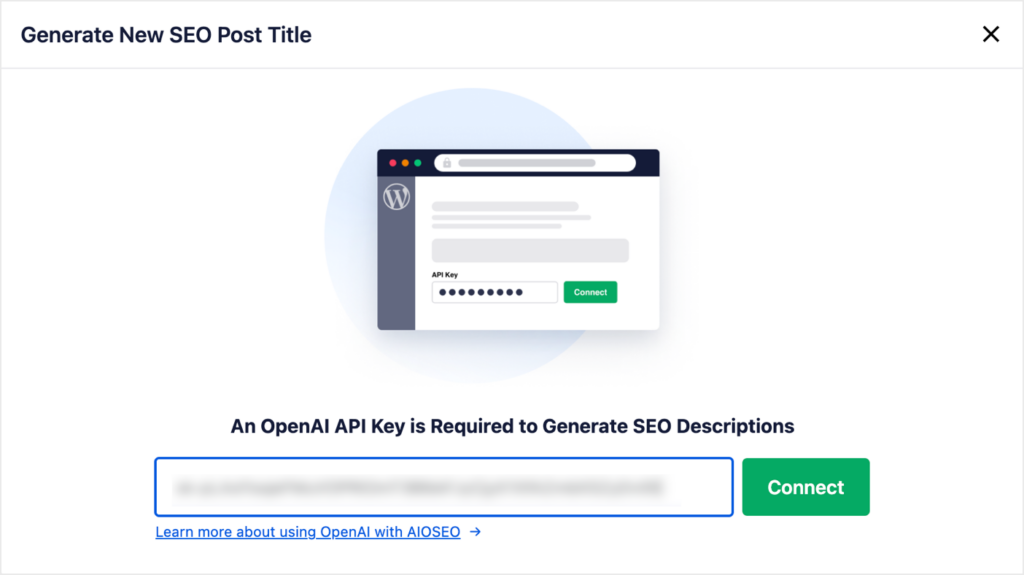
Here, you’ll reach a new screen where you can click Generate Titles.

If this step generates one of the below error messages, here is how to resolve it:
Error: “Please add some post content before generating new ideas.”
Solution: Chances are, you’re on a new page or post. To fix this, navigate away from the new page and enter an existing page. The AI title generator requires existing content to create ideas. Because of this, it only works on pages and posts that already contain content.
Error: “You exceeded your current quota, please check your plan and billing details.”
Solution: If you already have a paid account, head on over to OpenAI and request a quota increase. If you’re on a free account, you’ll need to upgrade to a paid OpenAI account.
Step 4: Generate SEO Titles
Now that you’ve connected your OpenAI account to AIOSEO, you can generate SEO titles for your WordPress website.
To see title ideas, you’ll follow the same steps as earlier (when we added the API key).

The AI title generator will display 5 ideas for you to choose from.
Here are some examples of what it created for this blog post:
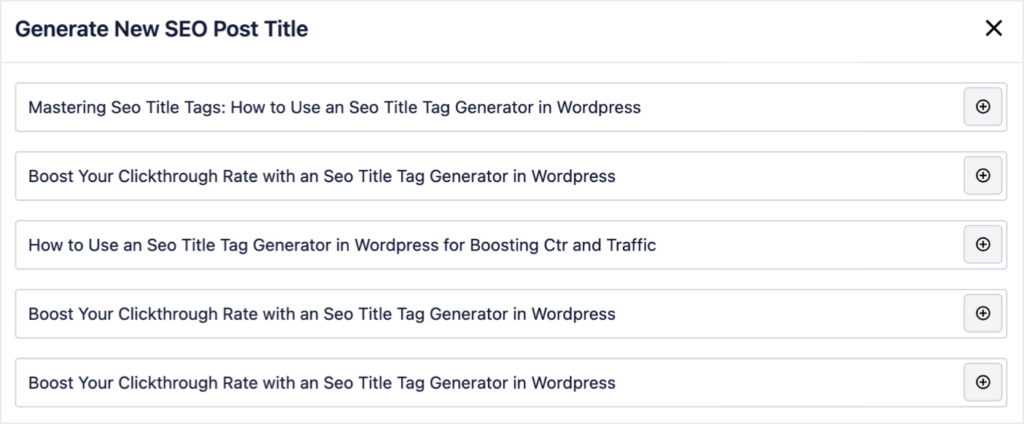
Tip: As you explore the list of options, you may uncover new content ideas. Add anything that catches your eye to your content marketing strategy and save it for another post or page.
From here, you can select the one you want by clicking the + button next to it. You can then customize the meta title to your preferences.
And that’s it!
You have successfully used an SEO title tag generator to craft a compelling and click-worthy title for your website.
Tip: Want help with your meta descriptions too? This SEO page title generator can also write your meta descriptions! You’ll follow the same process we used for titles but work within the Meta Description section of the AIOSEO meta box. Here’s a complete walkthrough of the meta description generator.
ChatGPT: The Technology Behind the AIOSEO Title Generator
At the heart of the AIOSEO Title Generator lies ChatGPT, a cutting-edge language processing tool developed by OpenAI.
This technology uses extensive databases to understand and replicate human language patterns and rules.
When it comes to the SEO title tag generator, ChatGPT takes user input (your content) and applies its “knowledge” to formulate titles that fulfill SEO best practices.
The result?
Meta titles that compel users to interact with your content and convey important information to search engines.
6 Tips to Boost Your CTR With SEO Titles
Now that you know how to generate SEO title tags in WordPress, let’s look at tips for using them to grow your CTR.
1. Include Your Primary Keyword
Using your primary keyword in the meta title establishes a direct connection between your content and the search queries your target audience uses. It showcases your page’s relevancy to their needs and helps search engines understand your content.
If you can include your primary keyword near the front of your title, even better.
2. Evoke Curiosity Without Giving It All Away
Your SEO title should be a teaser, not a spoiler. Offer users a glimpse of what’s inside with a catchy that entices them to learn more.
You can achieve this by:
- Hinting at a solution (“Unlock the Secret to…”)
- Using intriguing language (“surprising” or “mind-bending”)
- Showing off stats (“Grow Conversions by 30%”)
- Asking a question (“Are You Tired of…?”)
3. Leverage Emotional Triggers
Experienced copywriters tap into the power of emotions to connect with their audience.
They do this by using power words.
Power words are evocative words that trigger an emotional response from the reader. These words are irresistible to audiences, making them a marketer’s dream when trying to improve CTR.
Some examples of power words are:
- Life-changing
- Exclusive
- Guaranteed
- Instant
- Riveting
Need more ideas? Here’s a list of 700 power words.
4. Communicate Value
When you clicked to read this blog, you had a goal: to learn how to use SEO title tag generators in WordPress.
That’s why our SEO title reflects just that.
On the SERP, you have split seconds to draw in the reader and convince them that you have the solution, product, or service they need.
By calling out the issue or tangible solutions awaiting within your content, you communicate the value you provide. Use this to your advantage to increase CTR and get users one step closer to becoming a customer.
5. Be Unconventional
Stand out from the crowd by embracing creativity.
The best way to do this is by looking at what pages are already ranking for your target keyword. Is everyone using parenthesis? Use brackets. Are they calling out a 5-step fix? Make it 4.
Crafting titles that break the mold sets your content apart visually and in the mind of the user.
6. Use a Snippet Preview
A snippet preview is an easy way to make sure your SEO title tag looks exactly how you want it to on the SERP.
After all, nothing is more unattractive than a title that is too long and ends in the dreaded ellipses.
To make sure your SEO title is the correct length, a SERP snippet tool will show you if characters fit or get cut off.
The AIOSEO plugin makes this easy to view directly within your WordPress page or post.
Here’s how to do it:
First, open a post or page in editor mode. Then, scroll down until you see the Snippet Preview under AIOSEO Settings.

It’s as simple as that!
You can also toggle between a desktop user’s view (shown above) and a mobile device user’s view by clicking the icons in the upper right corner.
Now you can be confident that your SEO title will appear as you intended.
Note: Setting SEO meta titles and descriptions does not guarantee that search engines will use them. However, you can follow Google’s best practices for influencing title links and use your SEO page tag generator to increase the chances of it displaying your preferred text.
SEO Title Tag Generators: Your FAQs Answered
How do I create a title tag for SEO?
When creating a title tag for SEO, you should keep it relevant, concise, and click-worthy. Relevance means your title accurately reflects the content of the page. Being concise will ensure that your title isn’t cut off on the SERP. And click-worthiness brings visitors to your site. You’ll also want to include your target keyword, preferably up front.
Why should I use an SEO title tag generator?
An SEO title tag generator streamlines the title-creation process for web pages. In addition to saving you time, these AI tools consider important information to craft titles that are search-engine-friendly and attention-grabbing to users. Ultimately, this can improve your website’s clickthrough rate (CTR) and boost traffic.
Can you use an SEO title generator for YouTube?
Absolutely. SEO title generators are effective for any web content, including YouTube videos. In fact, it’s recommended. When you optimize your video titles, you cater to web search engines and elevate your video’s discoverability on the YouTube platform itself, which is a powerful search engine in its own right.
What are the meta tags for social media?
Your social media marketing strategy can also benefit from SEO meta data optimizations. Since social media platforms typically pull the post title and description from your meta tags, it’s important to optimize your blog post titles to grab the viewer’s attention. The help of a blog title generator can be useful for coming up with catchy titles that will make your post stand out and grow your social media statistics.
Save Time & Grow Your Traffic With an SEO Title Generator
SEO title generators are a powerful tool for business owners, marketers, bloggers, and anyone looking to streamline their content creation process. Headline generators help to save time in your workflow and support your optimization efforts across different platforms. When used effectively, you can grow your authority while increasing your CTR and traffic to your site.
We hope this post helped you implement an SEO title tag generator on your WordPress site. You may also want to check out other articles on our blog, like AI in SEO and tracking keyword rankings in WordPress.
If you found this article helpful, please subscribe to our YouTube Channel. You’ll find helpful tutorials there. You can also follow us on Twitter, LinkedIn, or Facebook to stay in the loop.
Disclosure: Our content is reader-supported. This means if you click on some of our links, then we may earn a commission. We only recommend products that we believe will add value to our readers.
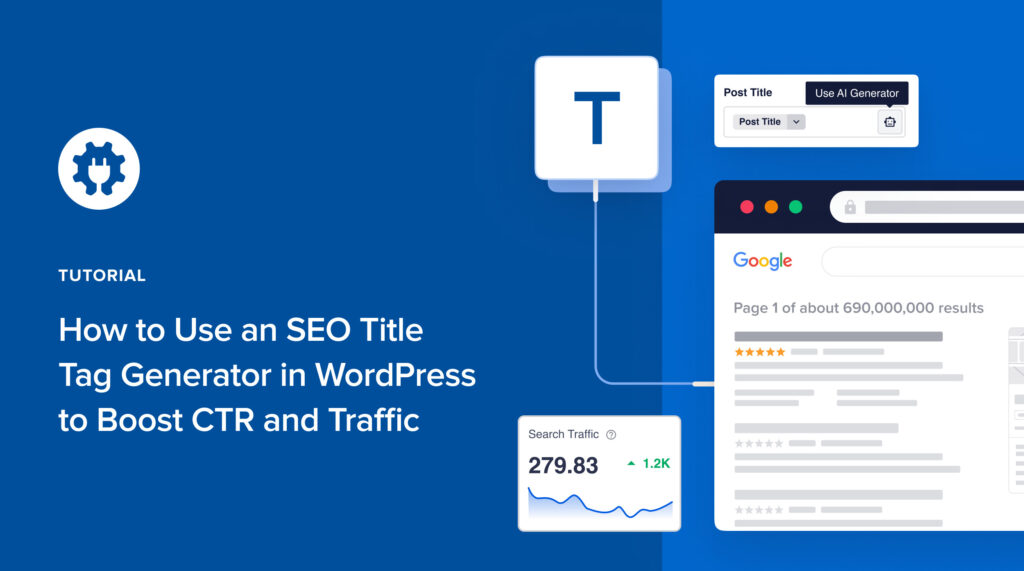

when I put my website above, I got a 404 Error message.
This SEO post is a concise treasure trove of actionable insights. Your ability to distill complex SEO strategies into clear, digestible tips is truly commendable. Every word here counts, and it’s evident that you understand the importance of optimizing not just for search engines but also for user experience. Looking forward to implementing these suggestions and watching our rankings soar! ???? #SEOExcellence
Mateusz Lomber – Grafik Freelancer